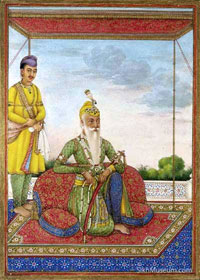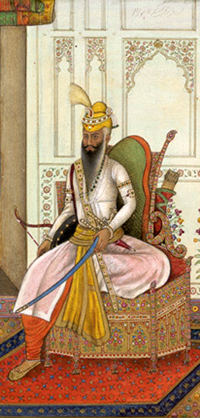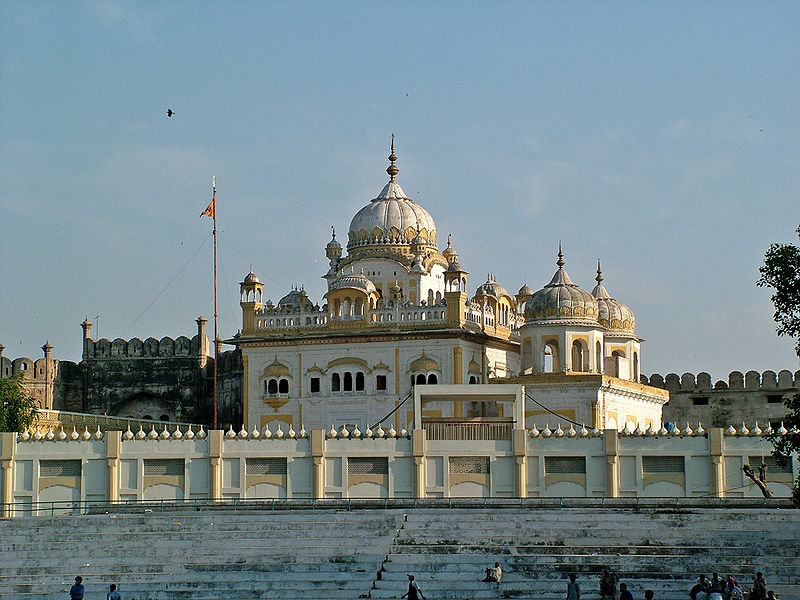Maharaja Ranjit Singh History
Early Life
Ranjit Singh was born on 13th November 1780 in Gujranwala now in modern day Pakistan, into a Sikh Sansi(nomadic tribe) family. At the time, much of Punjab was ruled by the Sikhs, who had divided the territory among factions known as misls.
Ranjit Singh's father Mahan Singh was the misaldar ("commander", "misl leader") of the Sukerchakia misl and controlled a territory in west Punjab based around his headquarters at Gujranwala. As a child he suffered from smallpox.This consequently resulted in the loss of sight in his left eye. His mother was Mai Raj Kaur. Mai Raj Kaur was the daughter of the king of Jind. She was also known by the name of ‘Malwain’. His father died while Ranjit Singh was 12 years old. After the death of his father, Ranjit Singh was raised by Sada Kaur of the Kanheya misl. He took over as misaldar of the Sukerchakia misl at the age of 18.

A Fearless Warrior
This great warrior, fearless soldier, able administrator, clement ruler, statesman and liberator of Punjab died on 27 June 1839. His Samadhi (memorial) is located in Lahore, Pakistan.
After several campaigns, his rivals accepted him as their leader, and he united the Sikh factions into one state and he took the title of Maharaja on April 12 1801 (to coincide with Baisakhi day), with Lahore serving as his capital from 1799.
In 1802 he took control of the holy city of Amritsar. He brought law and order, yet was reluctant to use the death penalty. He stopped India's non-secular style and practises. He treated both Hindus and Muslims equally. He banned the discriminatory religious tax the "jizya" on Hindus and Sikhs which had been imposed by the various Muslim rulers.
Respect From all Quarters
The majority of Ranjit Singh's subjects were Muslim and yet they had an intense loyalty towards him and his Sikh's who showed tolerance, even respect towards their religion, its practises and its festivals. Maharaja Ranjit Singh was the first Asian ruler to modernize his army to European standards and was well known for filling the leadership positions in his Darbar with men of varied Religions. People were recognized and promoted on their ability and not their religion.

The respect shown by those who worked for the Maharaja is best highlighted, perhaps, by the Sikh Empire's foreign minister, a Muslim named Fakir Azizuddin, who when meeting with the British Governor-General George Eden, 1st Earl of Auckland was asked, which of the Maharaja's eyes was missing, he replied, "the Maharaja is like the sun and the sun has only one eye. The splendour and luminosity of his single eye is so much that I have never dared to look at his other eye." (The Maharaja had lost the sight of one eye from an attack of smallpox as a child. In a land and time when being blinded disqualified one from ruling, having the sight of only one eye was never a problem for Ranjit Singh, who remarked that it gave him the ability to see things more acutely.)
The Governor General was so pleased with the reply that he gave his gold wrist-watch to the Maharaja's Minister during their meeting at Simla. The Empire was effectively secular as it did not give preference to Sikhs, or discriminate against Muslims, Hindus or even atheists.
It was relatively modern and had great respect for all religions and non-religious traditions of the Empire's citizens. The only main prominent religious symbols of the empire were the Maharaja and royal family being Sikh (but not Khalsa) and the Army being dominated by Sikh nobles and the Khalsa warriors.
The Maharaja never forced Sikhism on his subjects. This was in sharp contrast with the attempted ethnic and religious cleansing of past Muslim rulers - Afgani or Mughal. Ranjit Singh had created a state based upon Sikhi's noble traditions, where everyone worked together, regardless of their background. One where its citizens looked at the things they shared in common, e.g. being Punjabi traditions, rather than any religious differences.
Muslims and the Sarkar-i-Khalsa
Shah Mohammed (a famed Sufi poet of the Punjab) writes in his, Jang Namah on the decline of Ranjit Singh’s kingdom:
"Ranjit Singh was a born warrior-king who gave his feel to the country. He conquered Kashmir, Multan, Peshawar and made Chamba, Kangra and Jammu bow before him. He extended his territories upto Ladakh and China and struck his coin there. O Shah Mohammed! For fifty years he ruled with satisfaction, glory and power."
For Shah Mohammed, Punjabi Muslims became part and parcel of the Sarkar-i-Khalsa (the Sikh Kingdom of Ranjit Singh), where in the past they had depended on the Afghans, Arabs, Pashtuns, Persians and Turks, who had consistantly betrayed them.
The Maharaja's Military
Main article: Army of Maharaja Ranjit Singh

The Maharaja developed a formidable military machine that helped him carve out an extensive kingdom and maintain it amid hostile and ambitious neighbours. The creation of this empire was a result of his own genius. From the scanty force that he inherited, comprised almost solely of horsemen, a force where everyone brought his own horse and whatever weapon he could afford or acquire, without any regular training or organization the Maharaja developed Asia's only modern army, well ahead of the Japanese restructuring of the 1880s, one which was able to stop the British advance at the Sutlege.
What held his troopers together was their personal loyalty to their leader. The guerilla warfare system had stood the Khalsa in good stead during the turbulent and anarchic eighteenth century, but was unsuited to the needs of the changing times and to Ranjit Singh's ambition to establish a secure kingdom.
Early in his career, he had watched how the British troops with their systematic training and their discipline, had vanquished Indian forces vastly superior in numbers. He had also realized how crucial in warfare was a well-drilled infantry as well as artillery. In 1802, soon after his occupation of Amritsar, he engaged some deserters from the army of the East India Company to train his own platoons of infantry. He even sent some of his own men to Ludhiana to study the British methods of training and tactics.
On 7 July 1799, the Sikh militia of the Sukerchakia chief, Ranjit Singh, occupied of Lahore.[22] For that brief half century, from 1799 to 1846, Lahore recovered under the patronage of Ranjit Singh and his successors. Ranjit Singh consolidated the Sikh misls who had ruled more or less independently during the eighteenth century under a unified command and in 1799 he established Lahore as the administrative capital of a new Sikh kingdom. Nearby Amritsar became the spiritual and commercial center of the kingdom in 1802, after Ranjit Singh's troops occupied the city and the maharaja announced his intention to extend patronage and protection to the city's leading groups.

The Samadhi of Emperor Ranjit Singh in Lahore, Pakistan.
While much of Lahore's Mughal era fabric lay in ruins by the end of eighteenth century, rebuilding efforts under the Sikhs were focused on the Sikh community as many visitors to the city noted that much of the city was in disrepair and many of its Muslims and Mosques were pillaged and desecrated; in many instances components were pillaged from ancient structures to build Sikh temples and houses. The grand Badshahi mosque was used as a horse stable and the minaret used as targets by the Sikh artillery regiments. Much of the city's Muslim inhabitants suffered considerably during this time and the period is generally associated with the desecration of much of Lahore's ancient architectural wonders.
Ranjit Singh death in 27 June 1839 ultimately ended his reign, while his son Dalip Singh became his successor. He was buried in Lahore and his samadhi still stands there.
